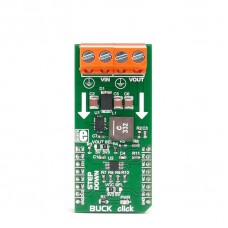BUCK click
BUCK click is a buck switching regulator that accepts a wide input voltage range of up to 40V and steps it down to 3.3V or 5V. The click carries the LT3976 40V, 5A, 2MHz step-down switching regulator with 3.3µA quiescent current. BUCK click communicates with the target microcontroller over the following pins on the mikroBUS™ line: PWM, INT, RS, CS.
Note: When all the usual conditions and proper cooling are met BUCK click can supply up to 5A of load current.
LT3976 regulator features
The LT3976 is an adjustable frequency monolithic buck switching regulator that accepts a wide input voltage range up to 40V. Low quiescent current design consumes only 3.3µA of supply current while regulating with no load. Low ripple Burst Mode operation maintains high efficiency at low output currents while keeping the output ripple below 15mV in a typical application.
The LT3976 can supply up to 5A of load current and has current limit foldback to limit power dissipation during short-circuit. A low dropout voltage of 500mV is maintained when the input voltage drops below the programmed output voltage, such as during automotive cold crank.
How the click works
There are two onboard screw terminals, one for connecting the external input supply, and the other for the output. There is also a multiplexer which chooses the resistor used for setting the switching frequency.
.jpg)
The multiplexer is used for selecting one of the four different resistors. Each of these resistors, if selected, sets different switching frequency:
| A0 | A1 | Selects resistor | Switching frequency [MHz] |
|---|---|---|---|
| 0 | 0 | R7 = 130k | 0.4 |
| 0 | 1 | R8 = 32.4k | 1.2 |
| 1 | 0 | R9 = 54.9k | 0.8 |
| 1 | 1 | R10 = 21.5k | 1.6 |
Specifications
| Type | Buck |
| Applications | Automotive battery regulation, portable devices, industrial supplies, etc. |
| On-board modules | LT3976 step-down switching regulator, MAX4634 4-channel CMOS analog multiplexer |
| Key Features | Thermal shutdown protection, output voltage can be set to 3.3V or 5V, 4 possible switching frequencies |
| Interface | GPIO |
| Input Voltage | 3.3V or 5V |
| Click board size | L (57.15 x 25.4 mm) |
Pinout diagram
This table shows how the pinout on BUCK click corresponds to the pinout on the mikroBUS™ socket (the latter shown in the two middle columns).
Jumpers and settings
| Designator | Name | Default Position | Default Option | Description |
|---|---|---|---|---|
| JP1 | VOUT SEL | Right | 3V3 | Output Voltage Selection 3V3/5V, left position 5V, right position 3V3. |
| JP2 | VCC SEL | Left | 3V3 | Power Supply Voltage Selection toward host MCU 3V3/5V; left position 3V3, right position 5V |
Programming
Code examples for BUCK click, written for MikroElektronika hardware and compilers are available on Libstock.
Code snippet
This code enables the buck regulator and detects if the voltage is within 8.4% of final regulation voltage.
01 void systemInit()
02 {
03 UART1_Init(9600);
04 }
05
06 void Buck_Init()
07 {
08 GPIO_Digital_Output( &GPIOC_BASE, _GPIO_PINMASK_2 );
09 GPIO_Digital_Output( &GPIOD_BASE, _GPIO_PINMASK_13 );
10 GPIO_Digital_Output( &GPIOA_BASE, _GPIO_PINMASK_0 );
11 GPIO_Digital_Input ( &GPIOD_BASE, _GPIO_PINMASK_10 );
12 BUCK_ENABLE_PIN = 1;
13 MUX_A0_PIN = 0;
14 MUX_A1_PIN = 0;
15 }
16
17 void Buck_Task()
18 {
19 if (PG_PIN == 1)
20 {
21 UART1_Write_text("Vout is within the final 8.4% of final regulation voltage");
22 UART1_Write_Text( "rn" );
23 delay_ms(1000);
24 }
25
26 }
27
28 void main()
29 {
30 systemInit();
31 Buck_Init();
32
33 while( 1 )
34 {
35 Buck_Task();
36 }
37 }
Downloads
mikroBUS™ Standard specificationLT3976 datasheet
MAX4634 datasheet
BUCK click schematic
Enter the code in the box below:




















